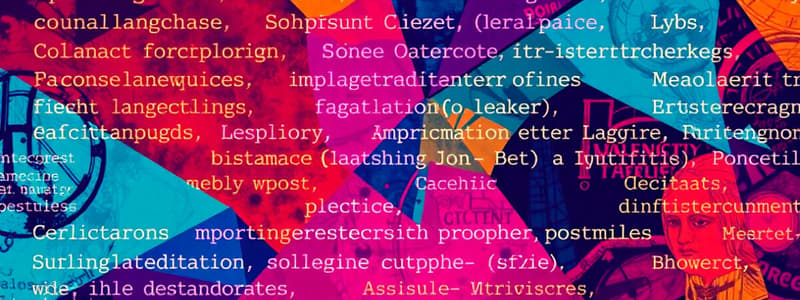Podcast
Questions and Answers
What is the primary function of a programming language?
What is the primary function of a programming language?
- To enhance user experience design
- To provide a set of instructions that a computer can follow (correct)
- To manage hardware resources
- To create graphical user interfaces
Which of the following defines the semantic aspect of programming?
Which of the following defines the semantic aspect of programming?
- The data types available in a language
- The rules governing program flow
- The structure of a program's code
- The meaning of the syntactic structures (correct)
Which of the following is not a core component of programming?
Which of the following is not a core component of programming?
- Control Structures
- Functions (correct)
- Data Types
- Variables
What distinguishes Object-Oriented Programming from Procedural Programming?
What distinguishes Object-Oriented Programming from Procedural Programming?
What is the main purpose of an Integrated Development Environment (IDE)?
What is the main purpose of an Integrated Development Environment (IDE)?
Which phase of the software development process focuses on understanding requirements?
Which phase of the software development process focuses on understanding requirements?
Which programming paradigm avoids changing state or mutable data?
Which programming paradigm avoids changing state or mutable data?
What is the role of version control systems in software development?
What is the role of version control systems in software development?
Study Notes
Definition
- Programming is the process of creating a set of instructions that a computer can follow to perform specific tasks.
Key Concepts
- Programming Language: A formal language that consists of a set of instructions used to produce various kinds of output. Examples include Python, Java, C++, and JavaScript.
- Syntax: The set of rules that define the combinations of symbols that are considered to be correctly structured programs in a given programming language.
- Semantics: The meaning of the syntactic structures, determining what the instructions do when executed.
Core Components
- Variables: Storage locations in a program that hold data which can be changed during execution.
- Data Types: Classes of data that dictate what operations can be performed. Common types include:
- Integers
- Floats
- Strings
- Booleans
- Control Structures: Constructs that control the flow of execution in a program, including:
- Conditional Statements: (if, else, switch) that allow branching based on conditions.
- Loops: (for, while) that repeat a block of code multiple times.
Programming Paradigms
- Procedural Programming: Based on the concept of procedure calls; programs are structured as a series of instructions.
- Object-Oriented Programming (OOP): Organizes software design around data, or objects, instead of functions and logic.
- Functional Programming: Emphasizes the evaluation of functions and avoids changing state or mutable data.
- Declarative Programming: Focuses on the 'what' of the problem rather than the 'how', includes languages like SQL.
Development Tools
- Integrated Development Environment (IDE): Software that provides comprehensive facilities to programmers for software development. Examples include Visual Studio, Eclipse, and PyCharm.
- Version Control Systems: Tools (like Git) used to manage changes to source code over time, allowing collaboration and tracking history.
Software Development Process
- Planning: Understanding requirements and defining the scope.
- Design: Architecting system solutions that meet requirements.
- Implementation: Writing the actual code based on the design.
- Testing: Verifying that the software works as intended and fixing any issues.
- Deployment: Releasing the software to users.
- Maintenance: Ongoing updates and bug fixes after deployment.
Best Practices
- Code Readability: Write clear, understandable code with proper naming conventions and comments.
- Modular Design: Develop programs in smaller, manageable sections (modules) to enhance maintainability and reusability.
- Testing & Debugging: Regularly test code to identify and fix bugs promptly.
- Documentation: Provide clear documentation for code functions, modules, and overall architecture.
Common Challenges
- Debugging: The process of identifying and resolving bugs or errors in code.
- Scalability: Ensuring that a program can handle growth and increased workloads.
- Performance Optimization: Improving efficiency in terms of speed and resource usage.
Programming Definition
- Programming is the process of creating instructions for a computer to perform tasks.
Programming Languages
- Programming languages are formal systems used to give instructions to computers.
- Some popular programming languages include: Python, Java, C++, and JavaScript.
Programming Language Components
- Syntax: The rules defining the structure of valid code.
- Semantics: The meaning of the structured code, determining its actions.
Core Programming Concepts
- Variables: Storage locations that hold changeable data during program execution.
- Data Types: Classifications of data that define allowable operations.
- Common data types include: Integers, Floats, Strings, and Booleans.
- Control Structures: Components that direct program execution flow.
- Conditional Statements: (if, else, switch) allow branching based on conditions.
- Loops: (for, while) repeat a block of code multiple times.
Programming Paradigms
- Procedural Programming: Focuses on structured sequences of instructions (procedures).
- Object-Oriented Programming (OOP): Designs software around objects (data entities) and their interactions.
- Functional Programming: Emphasizes function evaluation and avoids changing data states.
- Declarative Programming: Focuses on the "what" rather than the "how", common in languages like SQL.
Development Tools
- Integrated Development Environment (IDE): Software providing comprehensive features for software development.
- Examples include Visual Studio, Eclipse, and PyCharm.
- Version Control Systems: Tools (like Git) for managing code changes over time, facilitating collaboration and tracking history.
Software Development Process
- Planning: Defining requirements and scope.
- Design: Architecting solutions that meet specifications.
- Implementation: Writing the actual code.
- Testing: Verifying software functionality and fixing issues.
- Deployment: Releasing the software to users.
- Maintenance: Ongoing updates and bug fixes post-deployment.
Best Practices
- Code Readability: Writing clear, understandable code with helpful naming conventions and comments.
- Modular Design: Building programs in smaller, reusable modules.
- Testing & Debugging: Regularly testing code to identify and fix errors promptly.
- Documentation: Providing clear descriptions of code functions, modules, and overall architecture.
Common Challenges
- Debugging: Identifying and fixing errors or bugs in code.
- Scalability: Ensuring a program can handle increasing workloads effectively.
- Performance Optimization: Improving program speed and resource usage efficiency.
Studying That Suits You
Use AI to generate personalized quizzes and flashcards to suit your learning preferences.
Description
This quiz covers the foundational concepts of programming, including programming languages, syntax, semantics, and core components such as variables and data types. Test your knowledge on the essentials of creating instructions for a computer to perform specific tasks.


